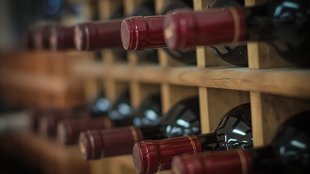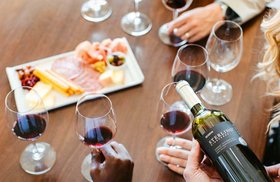Guide To Cellaring Wine Perfectly (Insider Tips You Need to Know)
When aged properly in a cellar, fine wine bottles, like the Château Margaux or a Rioja Gran Reserva, only get better with time.
If you have an expensive bottle at hand, you need some know-how on aging wine - for example, what are the optimal conditions for storing your older wine bottles and which wine storage suits you best.
To help you navigate through aging great wine, we will explore what wines are age worthy, how long you should cellar wine, and a few tips for cellaring your wine right.
Further reading
- Discover everything you need to know about Designing The Perfect Wine Cellar.
- Find out How To Build A Wine Collection The Easiest Way.
Should You Be Cellaring Wine?
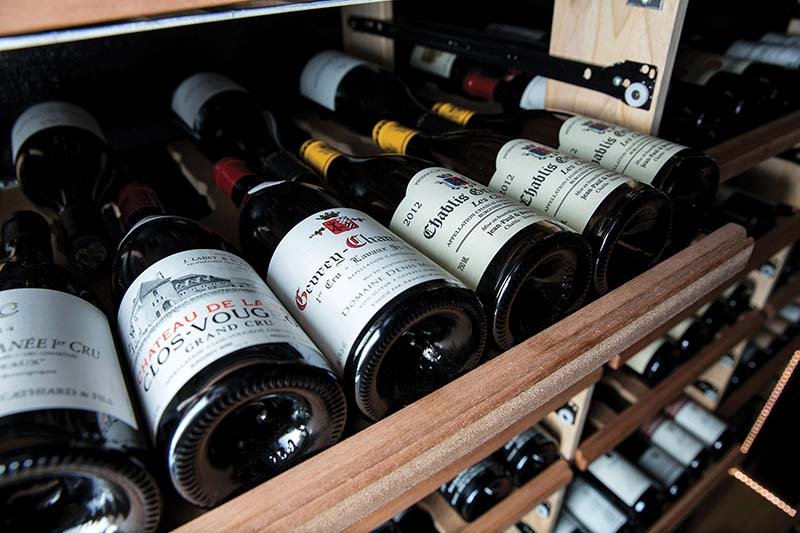
Today, most viniters make young wine that is meant to be drunk immediately after purchase.
However, some prestigious winemaker brands make great age worthy wine that benefits from a few years in the cellar under optimum conditions.
As fine wine matures, it begins to evolve, resulting in incredible, complex flavor and aroma notes. For example, fruit notes become more succulent, and tannin levels become smoother.
The sugar content, alcohol, and acidity also play a role in how a great wine bottle ages.
Cellaring fine wine is a great way to store special vintages like a specific wine bottle from your wedding or year of birth.
Here are just a few examples of red and white wines that are ideal for aging in the cellar:
- Red Bordeaux (Examples: Chateau Cheval Blanc, Château Margaux, Chateau Palmer, and others)
- White Burgundy (Examples: Domaine Leflaive, Louis Latour, and more)
- Vintage Port (Taylor Fladgate, Quinta do Noval, and others)
- Rioja Gran Reserva (La Rioja Alta 904, Barón de Ley)
- Dessert Wines from Austria (Rosenhof, Kracher, and more)
- German Riesling (For instance, Karthäuserhof and Schloss Johannisberg)
- South Australian Shiraz like Penfolds, Henschke, Standish
- Napa Valley Cabernet Sauvignon (Examples: Screaming Eagle, Harlan Estate Cab Sauvs)
- Oregon Pinot Noir likePonzi and Domaine Drouhin Oregon
How Long Should You Cellar Wine?
Generally, most red wine can age for a long time.
White wine with a screw cap tends to stay fresh for longer than white wine with a cork.
How long you age a bottle of wine depends on the wine style, bottle size, and vintage.
Let’s take a look at the wine aging times for different red and white wine styles:
1. Red Wine

Pick your favorite red wine style to find out how soon you should drink it:
- Drink within 1-3 years:Beaujolais, Dolcetto, Gamay, Lambrusco, Primitivo
- Drink within 3-5 years:Barbera, Crianza Rioja, Cotes du Rhone, Garnacha, Most Pinot Noir, Monastrell, Negroamaro, New world Merlot, Petite Sirah, Zinfandel
- Drink within 5-10 years: Aglianico, Carmenere, Chianti, Grenache, Malbec, Montepulciano d’Abruzzo, Most Cabernet Franc, Old World Merlot, Nero d’Avola, Pinotage, Reserve Rioja, Super Tuscans, Sangiovese based wines, Syrah, Tempranillo
- Drink within 10-20 years: Amarone, Bandol, Barbaresco, Barolo, Brunello di Montalcino, Douro reds, Dulce Monastrell (sweet red), Most Cabernet Sauvignon, Nebbiolo, Red Bordeaux, Sagrantino, some Sangiovese, some Tempranillo, Tannat
2. White Wine

Find out the aging time of some of the most popular white wine styles:
- Drink within 1-3 years: Assyrtiko, Albarino, Cava, Chenin Blanc, Dry Riesling, Gruner Veltliner, Gewurztraminer, Melon de Bourgogne, Moscato, Prosecco, Pinot Grigio/ Pinot Gris, Sauvignon Blanc, Torrontes, Vermentino, Verdicchio, Viognier, Vinho Verde
- Drink within 3-5 years: Arneis, Alsace white wine, Fiano, Garganega, Malvasia, New York Riesling, Oaked Chardonnay, Oregon Chardonnay, Oaked South African Chenin Blanc, Oaked Sauvignon Blanc, Semillon, Trebbiano
- Drink within 5-10 years: Alto Adige Pinot Grigio, Auslese German Riesling, Burgundy Oaked Chardonnay, Chablis, Hungary Furmint, Kerner, Muscat, Oaked Gruner Veltliner, Oaked Albarino, Petit Manseng, Sweet Loire Valley Chennin Blanc, Sicilian Grillo, White Bordeaux, White Cotes du Rhone, White Rioja, Verdicchio Matelica
- Drink within10-20 years: Beerenauslese German Riesling, Chablis (high quality), Hunter Valley Semillon, Ice Wine, Jura Savagnin, Late Harvest (Botrytized) Riesling, Malvasia (high quality), Rutherglen Muscat, Sauternes, Vendange Tardive Alsace White Wines
6 Useful Tips To Cellaring Wine
The best way to make sure your fine wine ages well is to implement successful cellaring techniques.
Here’s what you should keep in mind:
1. Choose A Cellaring Option

You don’t need a fancy underground cellar for long term storage.
You can opt for:
- Wine cabinet or a wine cooler: This option is ideal if your collection is less than 50 bottles.
- Wine room: A temperature-controlled wine room at home can hold anywhere between 10 to or over 500 wine bottles.
- Professional wine storage: Many companies, like Vinovest, now have wine storage options — this is perfect for avid wine collectors who want to build a collection and don’t want to keep upgrading their wine storage as the collection grows! In this case, you don’t even have to physically possess the bottles until they mature.
2. Lay The Bottles Horizontally

Store your aged wine bottles horizontally, so the cork stays moist.
If you keep the bottle standing vertically, the cork can dry out and shrink over time. This can lead to air slowly seeping into the bottle, causing oxidation and cork taint.
Laying the bottles on their side on a wine rack is also an excellent way to maximize space.
3. Set The Right Temperature And Humidity Levels

The right temperature and humidity levels are essential factors when aging wine.
- Temperature: The best temperature to store wine is between 45 and 65 degrees Fahrenheit.
- Humidity: The inside of a wine bottle has perfect humidity levels that keep one end of the bottle’s cork well hydrated. But to make sure the entire cork is moist, retains its elasticity, and keeps the wine sealed, the room also needs the right humidity levels (around 70%.)
4. Keep Light At Bay
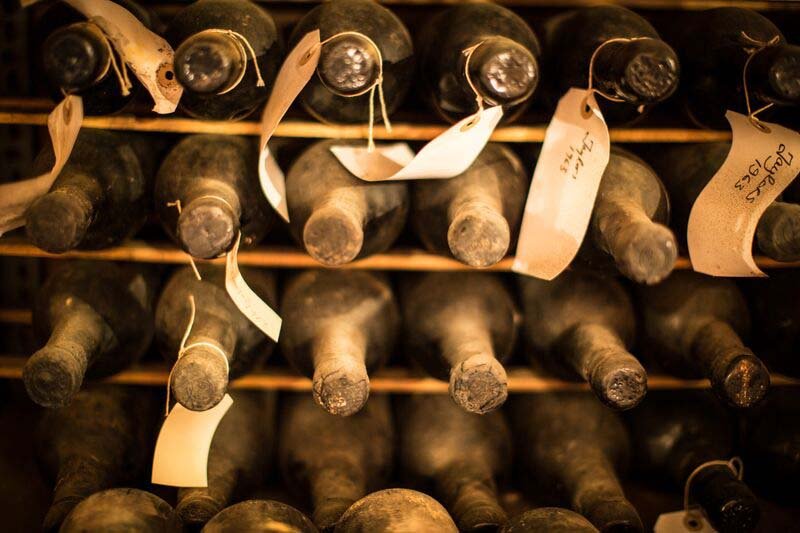
The heat and UV rays of sunlight can prematurely age and degrade wine. That’s why red wine is bottled in tinted glass to act as a barrier to light. So make sure the wine room is suitably dark at all times.
5. Reduce Vibrations
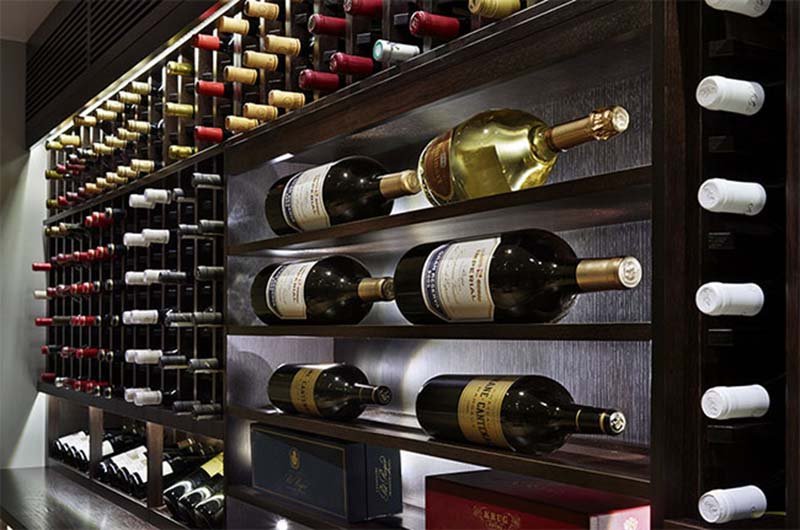
Any ardent wine enthusiast will tell you that constant vibration can cause a chemical reaction in the bottle and alter the wine’s characteristics.
But, generally, this won’t apply to you unless you’re going to shake your wine bottle vigorously or you live next to a train station, for instance!
6. Organize The Wine Cellar
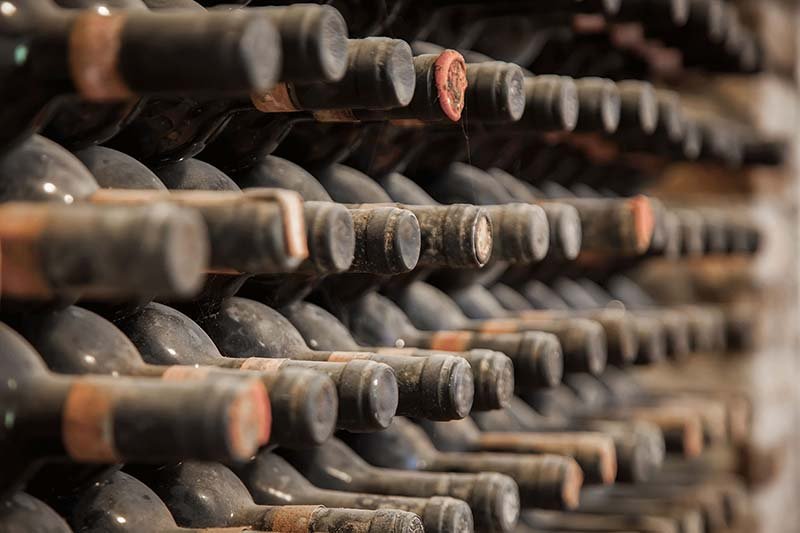
An organized wine cellar will help you track the old wine you have and when each one will be ready to drink. Log them on apps or go old school and use a cellar book.
You can organize your wines according to the drinking year or wine type (red, white, or sparkling wines.)
You can also add tags around the neck of your bottle and include information like wine name, wine region, vintage, drinking year. This way, you can view the important details without disturbing the bottle.
Cellaring Wine: The Gift That Keeps On Giving
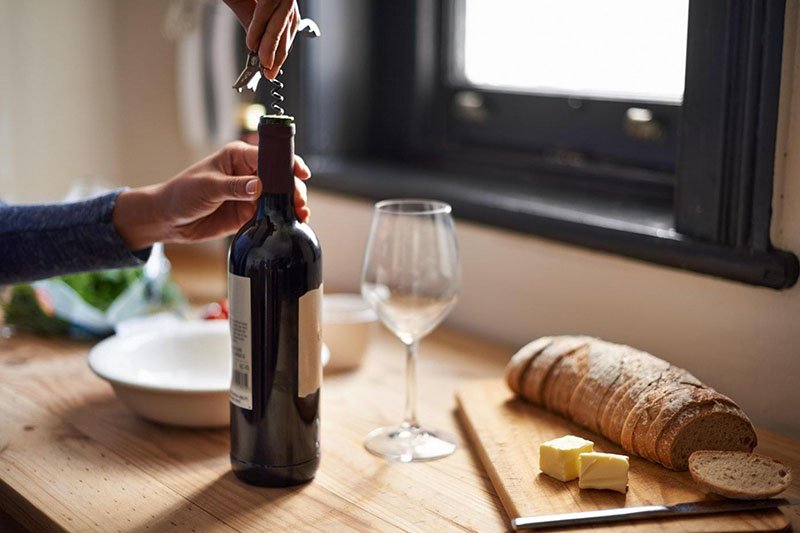
Cellaring wine is not for the faint of heart — it needs years of patience and the proper storage conditions.
But, ageing high-quality wine will be well worth the wait when you have fantastic, old wine to enjoy when the time is right. You can even sell it for a handsome sum when the time is right!
If you’d like to invest in fine wine and store your wines under perfect conditions, check out Vinovest. This wine investment company will help you with long term storage, plus buying and selling your fine wines.
